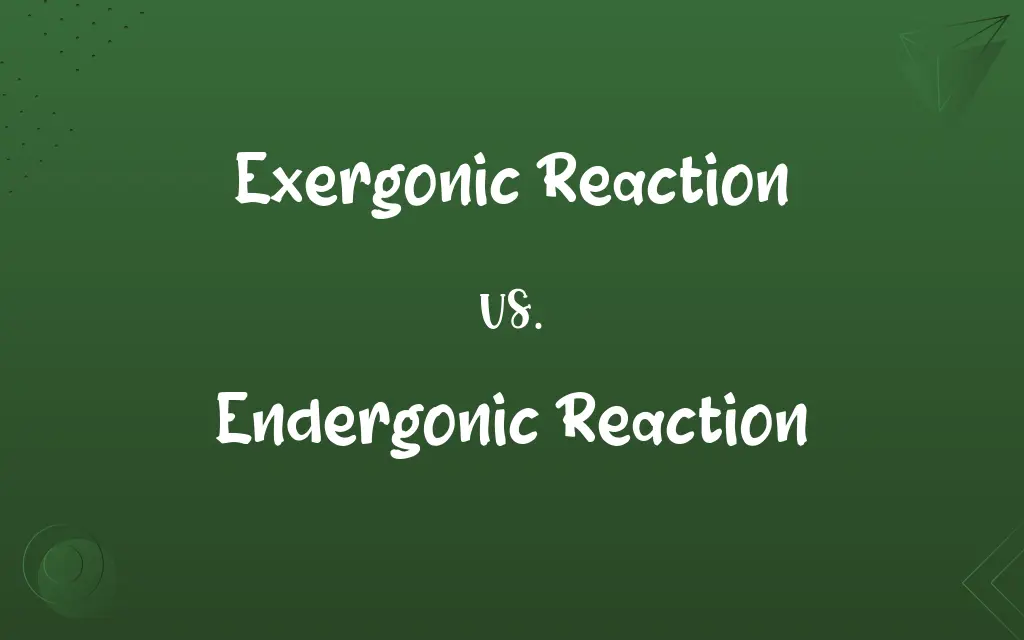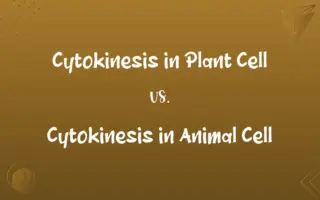Exergonic Reaction vs. Endergonic Reaction: Know the Difference

By Shumaila Saeed || Published on February 29, 2024
An exergonic reaction releases energy, occurring spontaneously, while an endergonic reaction requires energy input and is non-spontaneous.

Key Differences
Exergonic reactions are characterized by a negative Gibbs free energy change, indicating they release energy, typically in the form of heat or light. Endergonic reactions, in contrast, have a positive Gibbs free energy change, requiring an input of energy to proceed, often sourced from the surroundings or other reactions.
Shumaila Saeed
Feb 29, 2024
In exergonic reactions, the energy of the products is lower than the energy of the reactants, illustrating energy release. Endergonic reactions have higher energy products than reactants, reflecting the energy absorbed during the reaction process.
Shumaila Saeed
Feb 29, 2024
Exergonic reactions are generally spontaneous under given conditions, meaning they can occur without external assistance once initiated. Endergonic reactions are non-spontaneous, relying on continuous energy input to proceed, often coupled with exergonic reactions in biological systems.
Shumaila Saeed
Feb 29, 2024
Cellular respiration is a classic example of an exergonic reaction, where glucose is broken down, releasing energy. Photosynthesis is an endergonic reaction, where energy from sunlight is absorbed to convert carbon dioxide and water into glucose.
Shumaila Saeed
Feb 29, 2024
Exergonic reactions are common in catabolic pathways, breaking down molecules to release energy. Endergonic reactions are typical in anabolic pathways, where complex molecules are synthesized, requiring energy input.
Shumaila Saeed
Feb 29, 2024
ADVERTISEMENT
Comparison Chart
Energy Change
Releases energy (negative Gibbs free energy)
Absorbs energy (positive Gibbs free energy)
Shumaila Saeed
Feb 29, 2024
Product and Reactant Energy
Lower energy in products than reactants
Higher energy in products than reactants
Shumaila Saeed
Feb 29, 2024
Examples
Cellular respiration, combustion
Photosynthesis, synthesis of macromolecules
Shumaila Saeed
Feb 29, 2024
ADVERTISEMENT
Exergonic Reaction and Endergonic Reaction Definitions
Exergonic Reaction
Exergonic reactions have a negative Gibbs free energy change.
In an exergonic reaction, the total energy decreases, as seen in cellular respiration.
Shumaila Saeed
Jan 25, 2024
Endergonic Reaction
Endergonic reactions are not spontaneous.
The creation of complex carbohydrates from simpler ones is an endergonic process.
Shumaila Saeed
Jan 25, 2024
Exergonic Reaction
Exergonic reactions often occur spontaneously.
The rusting of iron is a spontaneous exergonic reaction.
Shumaila Saeed
Jan 25, 2024
Endergonic Reaction
In endergonic reactions, the products have more energy than reactants.
The formation of starch from glucose is an endergonic reaction.
Shumaila Saeed
Jan 25, 2024
Exergonic Reaction
Exergonic reactions typically result in the release of heat or light.
Fireworks exploding is an exergonic reaction that releases light and sound.
Shumaila Saeed
Jan 25, 2024
ADVERTISEMENT
Endergonic Reaction
Endergonic reactions have a positive Gibbs free energy change.
The synthesis of ATP in cells is an endergonic reaction, absorbing energy.
Shumaila Saeed
Jan 25, 2024
Exergonic Reaction
Exergonic reactions are common in catabolic processes.
Breaking down sugars in the body is an exergonic process, providing energy.
Shumaila Saeed
Jan 25, 2024
Endergonic Reaction
An endergonic reaction requires energy input to occur.
Photosynthesis is an endergonic reaction, needing sunlight to produce glucose.
Shumaila Saeed
Jan 25, 2024
Exergonic Reaction
An exergonic reaction releases energy as it proceeds.
The combustion of wood is an exergonic reaction, releasing heat and light.
Shumaila Saeed
Jan 25, 2024
Endergonic Reaction
Endergonic reactions are typical in anabolic processes.
Muscle growth involves endergonic reactions to build protein structures.
Shumaila Saeed
Jan 25, 2024
Repeatedly Asked Queries
How is energy released in exergonic reactions?
Energy is typically released as heat, light, or transferred to other molecules.
Shumaila Saeed
Feb 29, 2024
Can exergonic and endergonic reactions occur together?
Yes, they often couple in biological systems, like in cellular respiration and photosynthesis.
Shumaila Saeed
Feb 29, 2024
What is an endergonic reaction?
An endergonic reaction requires energy input and is non-spontaneous.
Shumaila Saeed
Feb 29, 2024
What energy changes occur in endergonic reactions?
Endergonic reactions absorb energy, increasing the energy level of products.
Shumaila Saeed
Feb 29, 2024
What’s an example of an exergonic reaction in living organisms?
Cellular respiration, where glucose is broken down, is a key exergonic process.
Shumaila Saeed
Feb 29, 2024
What defines an exergonic reaction?
An exergonic reaction releases energy and often occurs spontaneously.
Shumaila Saeed
Feb 29, 2024
How do enzymes affect these reactions?
Enzymes can lower the activation energy, facilitating both exergonic and endergonic reactions.
Shumaila Saeed
Feb 29, 2024
Are endergonic reactions common in human metabolism?
Yes, especially in synthesizing complex molecules.
Shumaila Saeed
Feb 29, 2024
What’s a biological example of an endergonic reaction?
Photosynthesis in plants is an endergonic process requiring sunlight energy.
Shumaila Saeed
Feb 29, 2024
Are exergonic reactions always fast?
No, the rate can vary; some are fast, while others are slow.
Shumaila Saeed
Feb 29, 2024
Do endergonic reactions always require light energy?
No, they can use various energy forms, not just light.
Shumaila Saeed
Feb 29, 2024
What is the Gibbs free energy change in exergonic reactions?
It’s negative, indicating energy release.
Shumaila Saeed
Feb 29, 2024
Can exergonic reactions happen without enzymes?
Yes, but enzymes often speed up the reaction.
Shumaila Saeed
Feb 29, 2024
How do temperature changes affect exergonic reactions?
Increased temperature generally speeds up these reactions.
Shumaila Saeed
Feb 29, 2024
Are endergonic reactions reversible?
In theory, yes, but they require different conditions to reverse.
Shumaila Saeed
Feb 29, 2024
Does pH affect endergonic reactions?
Yes, pH can influence the rate and feasibility of these reactions.
Shumaila Saeed
Feb 29, 2024
What is the Gibbs free energy change in endergonic reactions?
It’s positive, indicating energy absorption.
Shumaila Saeed
Feb 29, 2024
What’s a common feature of all exergonic reactions?
Energy release is a universal feature.
Shumaila Saeed
Feb 29, 2024
Is ATP formation an endergonic reaction?
Yes, it requires energy to form ATP molecules.
Shumaila Saeed
Feb 29, 2024
Can exergonic reactions create energy?
They don't create energy but release stored chemical energy.
Shumaila Saeed
Feb 29, 2024
Share this page
Link for your blog / website
HTML
Link to share via messenger
About Author
Written by
Shumaila SaeedShumaila Saeed, an expert content creator with 6 years of experience, specializes in distilling complex topics into easily digestible comparisons, shining a light on the nuances that both inform and educate readers with clarity and accuracy.































































